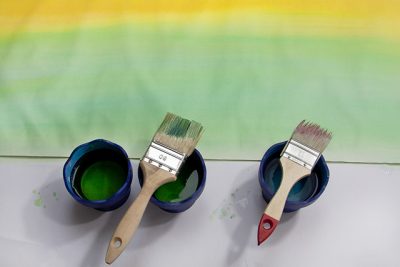Painting Life Hacks for a Cheaper and Cleaner Painting Project
Here are some very helpful tips for a more inexpensive and seamless painting project:
Aluminum
 A dry paint layer is a common occurrence in an experience in which one opens a container of paint. However, this is not charming to find, as it is often likely the paint solids will find their way to the paint itself. To solve this roll aluminum foil around the paint can cut the circle off precisely and put into the paint surface. Blow air into the can while you put back the lid, preventing drying.
A dry paint layer is a common occurrence in an experience in which one opens a container of paint. However, this is not charming to find, as it is often likely the paint solids will find their way to the paint itself. To solve this roll aluminum foil around the paint can cut the circle off precisely and put into the paint surface. Blow air into the can while you put back the lid, preventing drying.
Aluminum pie puns
When a painting project pops up, put the pie pan made of aluminum under the dry layer of paint, as you make ready the drip catcher. A lot of cleaning time saved as you can quickly trash the pan. Recycling is an option as it is possible to wash and preserve for future use.
Basters
Transferring of the paint from a larger to a smaller can is one of the toughest parts of the paint job process. To simplify the job and avoid spill, only use the busters to transfer the paint. If possible, it should be one of the painting tools in the workshop for solvent transfer as well as the liquid chemicals
Bottles
To avoid paint splatter during a painting project, making a hole opposite side of the gallon handles help in the creation of a neat paint dispenser. Add the color to the gallon to about an inch away from the created hole. The hole is used to eliminate excess paint from the painting brush before lifting. Cutting the gallons at about halves also creates a can that can be used as a bin for the disposables should many people be involved in the same project.
Buckets
For you to avoid spilling paint as you climb ladders, a huge bucket can house all the painting equipment like the knife putty rags and a scrapper and to hang the brush and the buckets, use the paint can hooks. The more the tools and the equipment the larger the bucket should be.
Coat hangers
When on a ladder and one hand paints while the other holds on, what holds the paint can? From the wire rack, cut about an inch of a hook using a pair of wire snips, then twisted firmly around the paint can handle, thus creating a handy hanger.
Coffee cans
After a day’s job, the coffee cans provide the ideal tool to house thinners in which the brushes can be soaked when planning for the following day’s job. Create a perfect space on the lid and insert the brush until a half-inch gap exists between the bristles of the brush and the base of the can. Suppose it has no lid, suspend the brush making sure it does not touch the base of the can.
Garden hose
Cutting a small section of the garden hose and then carefully cutting along the obtained piece helps create a tool that totally prevents getting cuts from the thin wired paint can handles.
Ice scraper
Sometimes paint spills usually find their way onto the acrylic bath tabs. Scrubbing these off safely without having to scratch the surface of the bath tab, involve the use an ice Scrapper. It also works wonderfully on any other non-metallic surfaces.
Kool-Aid
To change the color of a water-based latex paint, mix different unsweetened flavors of Kool-Aid. Moreover mixing water with unsweetened Kool-Aid creates different watercolors of your choice. Its stains though can be tough to clean and should not be given to kids.
Margarine tubs
A little touch up on the walls without having to drag around huge gallons of paint, it is advisable to pour a little paint into a margarine tub and carry it along in the touch-up activity. Wrap around clothing to act as a landing ground for spills. Store leftovers in containers that have lids.
Masking tape
The groove of the paint can be filled with paint and avoid this, use a masking tape to cover the rim’s top.
Milk cartons
If you do not want to save the paint leftovers after a small painting project, an empty carton of milk will be useful as a hole created on the top of the box, and paint leftovers poured into the container and then taken to the trash can for disposal.
Newspaper
Its needles to buy the carpenters rape or the thick masking to cover the frames and the glasses during a painting project so as to avoid spills on those particular areas. Instead, pick the newspaper leaves, wet them, and stick it on the wooden glass frames. It adheres well, and it is easy to remove after the job being cost effective band time saving.
Paper bags
It is pointless to make a mess each time you spray paint an item. Instead, fit the object in a large shopping paper bag and spray it away. The kit contains the excess paint spray and once dry, remove the item while tossing the paper bag in the garbage can.
Paper plates
These can be put on the paint can when scraping the paintbrush on the side of the paint can to avoid it dropping on the floor.
Petroleum jelly
When painting and the removal of all the metallic handles and items are not much of an option, application of the petroleum jelly is necessary on these metal items because with that; paint will not stick to them. After the job, simply wipe it all off and it will be back to normal.
Plastic bags
When taking a lunch break and you tend to continue, one does not have to clean the brush and instead you can stick it in a plastic bag, and it will be just wet enough to keep when you return. When taking a long break, freeze the bag of brush and defrost a day before using again.
Plastic lids
In the case of redoing a ceiling and paint spills in one’s face is an issue, making a small hole on the plastic cover and then forcing the brush through creates a shield. With that, it helps hold the paint spills that could have otherwise reached one’s face. Still, one should take note not to put too much paint while working on points above the head.
Rubber bands
The mess created by excess paint on the brush can be removed on the side of the can. A rim filled with paint ends up spilling during little movements. Avoid such by fixing a rubber band across the top so that excess paint on the brush falls back into the can when hitting on the rubber band.
Vinegar
Paint on cement peels after a while. Treating the floor to white vinegar before paint application helps keep the paint on. The vinegar is to dry before the actual painting process begins. This powerful technique helps keep paint on galvanized surfaces.





